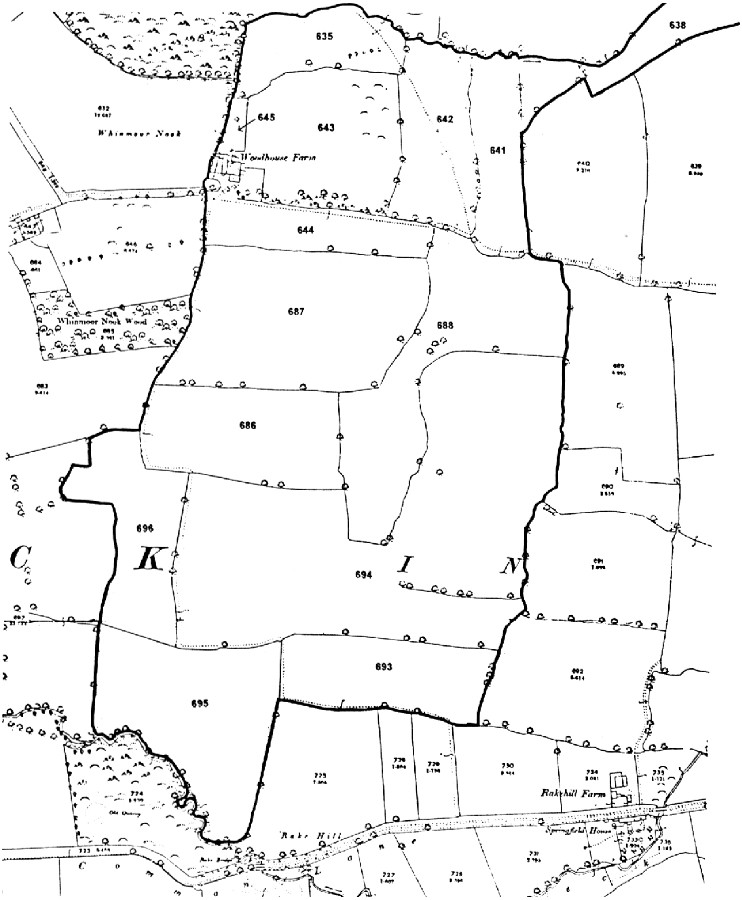
Woodhouse Farm showing the field divisions in 1917
| No. | Name | Use | Contents (a.r.p.) | Annual value (£.s.d.) |
| 558 | Rakehill | a.&.m | 5.1.39 | 4. 2. 5 |
| 559 | Six acres | Ar | 6.2.33 | 4.16. 0 |
| 567 | House, yard, etc. | -. | 3. 0 | 1.10. 0 |
| 568 | House Close | P | 8.3.39 | 6. 5.11 |
| 569 | Soupasture | P | 4.3.39 | 3. 9.11 |
| 570 | Old Pasture | P | 5.2.35 | 3. 8. 6 |
| 571 | do. do. | P. | 4.1.30 | 2.13. 3 |
| 572 | Ing | a&m | 4.0. 2 | 3. 0. 2 |
| 573 | Four Acres | Ar | 4.0.14 | 3. 1. 3 |
| 574 | Nine Acres | Ar | 8.2.36 | 6.10. 8 |
| 575 | Four Acres | F | 4.3.32 | 3. 8. 6 |
| 576 | Eight Acres | F | 7.3.34 | 5.11. 6 |
| 577 | Ing | a&m | 5.2. 5 | 4. 2.11 |
| 578 | Twelve Acres | F | 11.2.27 | 8.15. 0 |
| 579 | Rakehill | F | 6.0.29 | 5.11. 3 |
| 580 | do. | Ar | 6.1.21 | 4.15. 6 |
| 581 | Four Acres | Ar | 4.1.32 | 3. 6. 9 |
| 582 | Crabtree Close | Ar | 6.3. 2 | 5. 8. 2 |
| 583 | Ing | Ar | 4.2. 5 | 3. 7 11 |
| 584 | Slater Close | Ar | 3.3.36 | 4.15. 8 |
| No. | Name | (a.r.p.) | Rental (£.s.d.) | |
| 495 | Farmhouse etc. | 0.1.13 | 9.12. 0 | |
| 494 | Garth | Grass | 0.2. 0 | 0.10. 0 |
| 490 | Low Home Meadow | Grass | 5.0.13 | 3. 0.11 |
| 496 | Home Meadow | Ar & grass | 8.3. 9 | 7. 0.11 |
| 496a | Stripe | Ar & grass | 0.3. 0 | - |
| 497 | Rough Close | Grass | 5.2.35 | 2.14.10 |
| 498 | do. do. | Arable | 4.1.19 | 3. 9.10 |
| 463 | Corner Close | Grass | 1.1.10 | 1. 1. 0 |
| 464 | Long Tongue | Grass | 3.3.31 | 3.18.11 |
| 499 | Part of House Close | Arable | 2.2. 5 | 2. 2. 6 |
| 500 | Wood Close | Grass | 4.2.25 | 4. 1.11 |
| 501 | Four Acres | Grass | 4.1. 2 | 3. 8. 2 |
| 502 | Eight Acres | Arable | 8.3.16 | 7. 1. 7 |
| 503 | Four Acres | Arable | 5.0. 6 | 4. 0. 7 |
| 504 | Eight Acres | Arable | 8.0.17 | 6. 9. 8 |
| 505 | Newsham Flatt | Ar & grass | 4.2.39 | 3.15.10 |
| 506 | New Flatt and part of Close House | Arable | 8.0. 3 | 7. 7. 6 |
| 507 | First Isott Flatt | Arable | 6.2.31 | 5.17.10 |
| 512 | Second Isott Flatt | Arable | 4.1.25 | 3.17. 7 |
| 513 | Third Isott Flatt | Arable | 6.2. 0 | 5.14. 5 |
| 508 | Twelve Acres | Arable | 11.2.30 | 9. 7. 0 |
| 509 | Little Beck | Arable | 6.2.20 | 5. 6. 0 |
| 510 | First Beck Close | Arable | 5.1. 3 | 4.12. 9 |
| 511 | Second Beck Close | Arable | 5.3.16 | 5.12. 3 |
| Total content | 124a.0r.6p | |||
| Gross Estimated Rental | £110.4s.0d |
| 'The Farm House containing on the ground floor two Living Rooms, Kitchen, Wash Kitchen, and Dairy, and on the first floor three Bedrooms, Man's Room and bacon chamber.' |
| 'The Farm Buildings comprise a Large Barn, Blacksmith's Shop, Shed, Cattle Sheds, Two Stables, Fotherum, Boxes, Hen House with Chambers over, Chop Place and Mistal for 20 beasts. Chop was a mixture if finely cut hay and straw use for feeding horses. |

| No. | Name | State | Quantity (acres) |
| 645 | Buildings, yard, garden and garth | 1.154 | |
| 635 | Low Home Meadow | Grass | 5.201 |
| 643 | Home Meadow | Grass | 8.794 |
| 642 | Rough Piece | Grass | 5.932 |
| 641 | ditto | Grass | 4.468 |
| 638 | Long Tongue | Grass | 5.290 |
| 688 | Wood Close | Grass | 12.083 |
| 644 | Four Acres | Grass | 4.607 |
| 687 | Twelve Acres | Grass | 14.057 |
| 686 | Eight Acres | Arable | 8.073 |
| 694 | Issot and Low Flat | Arable | 31.298 |
| 693 | Third Issot Flat | Arable | 6.788 |
| 696 | Little Beck Close | Arable | 6.655 |
| 695 | First and Second Ditto | Arable | 11.540 |
ARTHUR BANTOFT